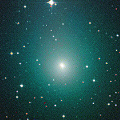
|
Now it is bright as 8.4 mag (Sept. 30, Marco Goiato). It stays bright as 8-9 mag until October. It moves southwards very rapidly after this. In the Southern Hemisphere, it becomes observable in excellent condition after this. In the Northern Hemisphere, it will be getting lower after this, and it will be unobservable in November.
Date(TT) R.A. (2000) Decl. Delta r Elong. m1 Best Time(A, h)
Oct. 5 23 3.21 -7 43.0 0.553 1.513 152 9.0 22:05 ( 0, 46)
Oct. 12 22 28.68 -21 50.4 0.688 1.543 131 9.5 21:04 ( 0, 32)
|

|
Now it is 11.6 mag (Sept. 25, Seiichi Yoshida). It stays bright as 11 mag until winter. It stays observable in good condition for a long time in the Northern Hemisphere. In the Southern Hemisphere, it will be getting lower gradually, and it will be unobservable in early December.
Date(TT) R.A. (2000) Decl. Delta r Elong. m1 Best Time(A, h)
Oct. 5 1 45.64 33 14.1 2.255 3.145 147 11.2 0:55 ( 0, 88)
Oct. 12 1 30.39 34 53.9 2.224 3.138 151 11.2 0:12 ( 0, 90)
|
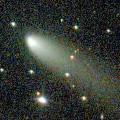
|
Now it is 11.7 mag (Sept. 25, Seiichi Yoshida). It stays 12 mag until November. It is observable in excellent condition in the Northern Hemisphere. It stays locating extremely low in the Southern Hemisphere.
Date(TT) R.A. (2000) Decl. Delta r Elong. m1 Best Time(A, h)
Oct. 5 2 51.33 41 4.2 0.562 1.444 133 11.6 2:00 (180, 84)
Oct. 12 2 51.11 44 10.9 0.566 1.462 136 11.6 1:32 (180, 81)
|
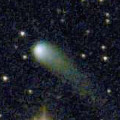
|
Now it is 12.2 mag (Sept. 11, Maik Meyer). It is expected to brighten up to 8 mag in 2020. It stays observable in good condition for a long time in the Northern Hemisphere. In the Southern Hemisphere, it will be getting lower gradually, and it will be unobservable in early December.
Date(TT) R.A. (2000) Decl. Delta r Elong. m1 Best Time(A, h)
Oct. 5 5 38.17 28 19.6 2.688 3.115 105 11.8 4:33 (337, 83)
Oct. 12 5 39.58 29 52.5 2.524 3.048 112 11.6 4:20 ( 0, 85)
|

|
It was observed in the SOHO spacecraft images in 2008 and 2014. It will approach to Sun down to 0.067 a.u. on Oct. 9. It was observable in the evening low sky until late September. But it was not recovered, fainter than 18.5 mag (Sept. 30, Michael Jager and Gerald Rhemann).
Date(TT) R.A. (2000) Decl. Delta r Elong. m1 Best Time(A, h)
Oct. 5 13 26.90 -5 49.5 0.818 0.256 11 13.7 19:03 ( 90,-10)
Oct. 12 12 58.20 -9 3.7 1.137 0.149 2 12.0 4:39 (269,-17)
|

|
It has not been observed yet in this apparition. Now it is fainter than 21.5 mag (Aug. 4, Erwin Schwab). It was expected to brighten up to 12 mag from August to September. But actually, it must be much fainter than expected. It is observable in good condition in the Northern Hemisphere. It is not observable in the Southern Hemisphere.
Date(TT) R.A. (2000) Decl. Delta r Elong. m1 Best Time(A, h)
Oct. 5 6 36.81 49 46.1 1.084 1.526 94 12.8 4:33 (216, 70)
Oct. 12 6 54.23 51 34.6 1.079 1.563 97 13.2 4:39 (207, 71)
|

|
Now it is 14.6 mag (Oct. 3, Chris Wyatt).
Date(TT) R.A. (2000) Decl. Delta r Elong. m1 Best Time(A, h)
Oct. 5 0 43.08 15 35.6 4.791 5.775 168 13.1 23:47 ( 0, 71)
Oct. 12 0 39.84 15 18.2 4.792 5.776 169 13.1 23:17 ( 0, 70)
|
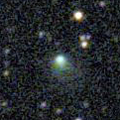
|
Now it is 13.3 mag (Oct. 1, Chris Wyatt). It is observable at 13.5 mag in good condition in autumn.
Date(TT) R.A. (2000) Decl. Delta r Elong. m1 Best Time(A, h)
Oct. 5 18 29.03 -14 18.1 1.604 1.829 85 13.7 19:03 ( 27, 36)
Oct. 12 18 44.08 -14 56.3 1.650 1.817 82 13.8 18:53 ( 27, 36)
|

|
Now it is 13.6 mag (Oct. 3, Chris Wyatt). It stays 13-14 mag for a long time in 2019. In the Southern Hemisphere, it is observable in good condition. In the Northern Hemisphere, it is not observasble until summer in 2020.
Date(TT) R.A. (2000) Decl. Delta r Elong. m1 Best Time(A, h)
Oct. 5 10 45.86 -81 20.2 3.155 3.105 77 14.1 4:33 (350,-33)
Oct. 12 11 49.83 -84 0.9 3.185 3.120 77 14.1 4:39 (353,-34)
|

|
Now it is 14.7 mag (Sept. 6, Ken-ichi Kadota). It is observable at 14 mag in good condition in autumn.
Date(TT) R.A. (2000) Decl. Delta r Elong. m1 Best Time(A, h)
Oct. 5 8 45.36 12 24.6 2.813 2.486 60 14.2 4:33 (284, 40)
Oct. 12 8 54.80 11 33.4 2.763 2.516 65 14.2 4:39 (289, 44)
|

|
It brightened rapidly. Now it is very bright as 11.3 mag (Sept. 22, Thomas Lehmann). It may fade out rapidly after this. In the Southern Hemisphere, it stays observable in the low sky until it becomes fainter than 18 mag in winter. It is not observable at all in the Northern Hemisphere.
Date(TT) R.A. (2000) Decl. Delta r Elong. m1 Best Time(A, h)
Oct. 5 12 5.93 -59 21.2 2.090 1.729 55 14.3 4:33 (323,-34)
Oct. 12 12 54.01 -61 16.6 2.173 1.784 54 14.7 4:39 (325,-37)
|

|
It brightened up to 7.7 mag in June in 2018 (June 19, Juan Jose Gonzalez). Now it is fading. It has already faded down to 14.2 mag (Sept. 10, Thomas Lehmann). In the Southern Hemisphere, it stays observable for a long time until the comet will fade out. In the Northern Hemisphere, it is appearing in the morning sky, but it stays low for a while.
Date(TT) R.A. (2000) Decl. Delta r Elong. m1 Best Time(A, h)
Oct. 5 7 4.26 -31 50.7 4.938 4.913 82 14.6 4:33 (338, 19)
Oct. 12 7 3.19 -32 23.2 4.922 4.970 86 14.6 4:39 (345, 21)
|

|
Now it is 14.5 mag (Oct. 3, Chris Wyatt). In the Southern Hemisphere, it is observable for a long time. It stays low in the Northern Hemisphere.
Date(TT) R.A. (2000) Decl. Delta r Elong. m1 Best Time(A, h)
Oct. 5 23 10.45 -42 4.4 3.750 4.449 129 14.7 22:15 ( 0, 13)
Oct. 12 23 4.83 -40 54.5 3.836 4.477 124 14.7 21:42 ( 0, 14)
|
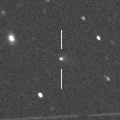
|
Now it is 15.5-16.0 mag (Sept. 8, Koremasa Hirofumi). It stays 15.5 mag until December, and it is observable in good condition.
Date(TT) R.A. (2000) Decl. Delta r Elong. m1 Best Time(A, h)
Oct. 5 23 49.51 -9 16.6 1.528 2.496 161 15.7 22:54 ( 0, 46)
Oct. 12 23 46.50 -9 36.6 1.540 2.476 153 15.7 22:23 ( 0, 45)
|

|
Now it is 16.0 mag (Sept. 8, Roberto Haver). It looks cometary. It is observable at 15.5 mag in good condition from October to November.
Date(TT) R.A. (2000) Decl. Delta r Elong. m1 Best Time(A, h)
Oct. 5 5 23.94 17 39.4 1.933 2.458 109 15.8 4:32 ( 0, 73)
Oct. 12 5 5.19 15 47.1 1.806 2.474 121 15.7 3:46 ( 0, 71)
|
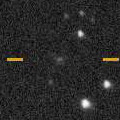
|
Now it is 15.0 mag (July 21, Taras Prystavski). It stays 16 mag for a long time from 2019 to 2020. It stays observable for a long time in the Southern Hemisphere. It is hardly observable in the Northern Hemisphere.
Date(TT) R.A. (2000) Decl. Delta r Elong. m1 Best Time(A, h)
Oct. 5 11 52.22 -63 24.5 3.881 3.485 59 15.9 4:33 (328,-34)
Oct. 12 12 0.92 -65 15.6 3.877 3.475 59 15.9 4:39 (331,-32)
|

|
Now it is 16.5 mag (July 27, Kevin Hills). It will brighten up to 14 mag in winter. It stays observable for a long time in the Southern Hemisphere, although it becomes low in November. In the Northern Hemisphere, it is not observable for a long time until August in 2020.
Date(TT) R.A. (2000) Decl. Delta r Elong. m1 Best Time(A, h)
Oct. 5 15 2.82 -43 57.8 3.061 2.542 50 16.0 19:03 ( 45,-13)
Oct. 12 15 7.80 -45 18.1 3.077 2.494 46 15.9 18:53 ( 45,-16)
|

|
Now it is 15.9 mag (Sept. 6, Ken-ichi Kadota). It is observable at 16 mag in good condition from summer to autumn. It locates somewhat low in the Southern Hemisphere.
Date(TT) R.A. (2000) Decl. Delta r Elong. m1 Best Time(A, h)
Oct. 5 3 48.32 29 8.1 1.406 2.181 129 16.0 2:56 ( 0, 84)
Oct. 12 3 47.48 29 16.2 1.370 2.202 136 16.1 2:28 ( 0, 84)
|
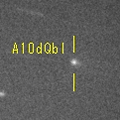
|
Now it is 15.8 mag (Aug. 26, Toshihiko Ikemura, Hirohisa Sato). It stays observable in good condition while the comet will be fading slowly after this.
Date(TT) R.A. (2000) Decl. Delta r Elong. m1 Best Time(A, h)
Oct. 5 3 34.21 3 44.7 1.548 2.378 136 16.0 2:42 ( 0, 59)
Oct. 12 3 33.63 2 36.3 1.547 2.421 143 16.1 2:14 ( 0, 58)
|
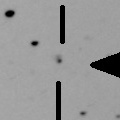
|
It looks cometary on the LCO (CTIO) image on Aug. 21. Now it is 15.7 mag (Aug. 28, Taras Prystavski). It is observable in excellent condition in the Southern Hemisphere. In the Northern Hemisphere, it locates extremely low for a while.
Date(TT) R.A. (2000) Decl. Delta r Elong. m1 Best Time(A, h)
Oct. 5 19 57.88 -40 40.4 6.146 6.419 101 16.2 19:03 ( 0, 14)
Oct. 12 19 53.83 -40 5.4 6.268 6.421 94 16.2 18:53 ( 4, 15)
|

|
Now it is 16.0 mag (Sept. 1, Toshihiko Ikemura, Hirohisa Sato). It stays 15-16 mag for a long time until 2021.
Date(TT) R.A. (2000) Decl. Delta r Elong. m1 Best Time(A, h)
Oct. 5 20 10.36 -28 44.1 4.540 4.928 107 16.2 19:16 ( 0, 26)
Oct. 12 20 6.75 -27 47.3 4.637 4.905 99 16.2 18:53 ( 2, 27)
|

|
Now it is 17-17.5 mag (Sept. 24, Koremasa Hirofumi). It will brighten very rapidly, and it will brighten up to 14 mag in winter. It is observable in excellent condition in the Northern Hemisphere. It locates low in the Southern Hemisphere.
Date(TT) R.A. (2000) Decl. Delta r Elong. m1 Best Time(A, h)
Oct. 5 2 24.24 46 14.1 1.042 1.870 132 16.5 1:33 (180, 79)
Oct. 12 2 24.53 46 52.6 0.976 1.836 136 16.2 1:06 (180, 78)
|

|
Now it is 16.3 mag (Sept. 1, Toshihiko Ikemura, Hirohisa Sato). It is expected to be observable at 5-6 mag for a long time from 2022 to 2023. In the Northern Hemisphere, it is not observable at the highlight from 2022 summer to 2023 summer. In the Southern Hemisphere, it stays unobservable for a while. But it will be observable in good condition at the highlight.
Date(TT) R.A. (2000) Decl. Delta r Elong. m1 Best Time(A, h)
Oct. 5 17 9.72 50 23.5 10.866 10.724 79 16.5 19:03 (130, 56)
Oct. 12 17 11.49 49 43.3 10.847 10.676 77 16.5 18:53 (128, 54)
|
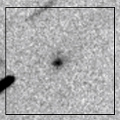
|
Now it is 16.9 mag (Sept. 25, Toshihiko Ikemura, Hirohisa Sato). The orbit is extremely hyperbolic with e=3.3. It is the first interstellar comet in history. It brightens up to 15 mag in December. In the Northern Hemisphere, it stays observable in good condition until early December. Then it will be getting lower, and it will be unobservable in mid January. In the Southern Hemisphere, it is not observable for a while. But it will appear in the morning sky in late October, then it will be observable in excellent condition.
Date(TT) R.A. (2000) Decl. Delta r Elong. m1 Best Time(A, h)
Oct. 5 9 33.81 21 30.1 2.937 2.463 52 16.8 4:33 (267, 35)
Oct. 12 9 46.71 18 23.4 2.795 2.377 55 16.5 4:39 (273, 37)
|
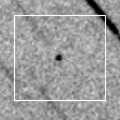
|
Now it is 16.7 mag (Aug. 9. Grorudalen Optical Observatory). It passed the perihelion on July 2. Then it must have brightened up to 13 mag, but it was not observable around that time. In the Northern Hemisphere, it stays observable in excellent condition until December when it becomes fainter than 18 mag. In the Southern Hemisphere, it stays locating low.
Date(TT) R.A. (2000) Decl. Delta r Elong. m1 Best Time(A, h)
Oct. 5 2 51.24 53 51.9 0.918 1.694 123 16.5 2:01 (180, 71)
Oct. 12 2 16.17 52 29.9 0.923 1.758 132 16.5 0:59 (180, 72)
|
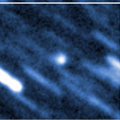
|
Now it is 15.8 mag (Oct. 2, Jean-Francois Soulier). It stays at 16 mag until December. It is observable in good condition in the Southern Hemisphere. It locates somewhat low in the Northern Hemisphere.
Date(TT) R.A. (2000) Decl. Delta r Elong. m1 Best Time(A, h)
Oct. 5 19 9.32 -27 51.7 1.507 1.867 94 16.6 19:03 ( 12, 26)
Oct. 12 19 21.31 -26 15.7 1.556 1.850 90 16.5 18:53 ( 14, 28)
|
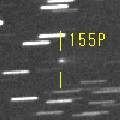
|
Now it is 17.1 mag (Sept. 14, Ken-ichi Kadota). It brightens rapidly, and it will be observable at 15 mag in good condition in winter. It locates somewhat low in the Southern Hemisphere.
Date(TT) R.A. (2000) Decl. Delta r Elong. m1 Best Time(A, h)
Oct. 5 8 11.31 19 15.5 1.935 1.857 70 16.8 4:33 (282, 50)
Oct. 12 8 29.35 18 38.1 1.864 1.840 73 16.5 4:39 (286, 53)
|
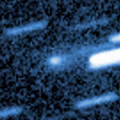
|
First return of a new periodic comet which brightened up to 16.5 mag in 2009. Now it is 16.2 mag (Sept. 11, Ken-ichi Kadota). It stays 16.5 mag until October. It is observable in good condition in the Northern Hemisphere. It locates low in the Southern Hemisphere.
Date(TT) R.A. (2000) Decl. Delta r Elong. m1 Best Time(A, h)
Oct. 5 8 45.92 16 47.5 1.457 1.322 61 16.6 4:33 (279, 42)
Oct. 12 9 5.97 14 32.3 1.458 1.351 63 16.8 4:39 (284, 43)
|
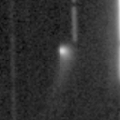
|
Now it is 16.8 mag (Aug. 2, Charles Morris). It will be fading after this. In the Northern Hemisphere, it stays observable in good condition for a long time. In the Southern Hemisphere, it stays extremely low for a long time.
Date(TT) R.A. (2000) Decl. Delta r Elong. m1 Best Time(A, h)
Oct. 5 3 6.60 48 55.1 3.429 4.097 125 16.8 2:16 (180, 76)
Oct. 12 2 51.09 48 3.4 3.384 4.134 133 16.8 1:33 (180, 77)
|

|
Now it is 16.6 mag (Sept. 2, Toshihiko Ikemura, Hirohisa Sato). It is observable at 16.5 mag in good condition from August to September. It will be fainter than 18 mag in November.
Date(TT) R.A. (2000) Decl. Delta r Elong. m1 Best Time(A, h)
Oct. 5 23 36.60 -4 30.7 1.614 2.582 161 16.9 22:40 ( 0, 50)
Oct. 12 23 25.06 -9 9.4 1.709 2.620 149 17.0 22:01 ( 0, 46)
|

|
Fading. Now it is 17.3 mag (Sept. 26, Katsumi Yoshimoto). It stays 17 mag from autumn to winter. It is observable in good condition in the Northern Hemisphere. It locates low in the Southern Hemisphere.
Date(TT) R.A. (2000) Decl. Delta r Elong. m1 Best Time(A, h)
Oct. 5 9 20.36 24 39.8 6.719 6.228 56 16.9 4:33 (265, 39)
Oct. 12 9 20.80 24 24.5 6.654 6.271 63 16.9 4:39 (270, 45)
|

|
Fading now. Now it is 15.8 mag (Aug. 24, Thomas Lehmann). In the Southern Hemisphere, it stays observable for a long time until it fades out. In the Northern Hemisphere, it will not be observable after this.
Date(TT) R.A. (2000) Decl. Delta r Elong. m1 Best Time(A, h)
Oct. 5 6 42.86 -42 55.6 5.040 5.081 86 16.9 4:33 (346, 10)
Oct. 12 6 39.97 -44 43.3 5.040 5.133 89 17.0 4:39 (353, 10)
|
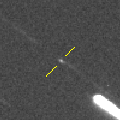
|
First return of a new periodic comet which brightened up to 18 mag in 2014. Now it is 17.5 mag (Sept. 13, Ken-ichi Kadota). It stays 17 mag until November. It is observable in good condition in the Northern Hemisphere. It locates extremely low in the Southern Hemisphere.
Date(TT) R.A. (2000) Decl. Delta r Elong. m1 Best Time(A, h)
Oct. 5 5 27.29 37 56.7 0.287 1.119 107 17.1 4:33 (185, 87)
Oct. 12 6 7.88 40 34.3 0.297 1.116 105 17.1 4:39 (197, 84)
|

|
It approached to Earth down to 0.3 a.u. in mid February, and brightened up to 5.5 mag (Feb. 13, Juan Jose Gonzalez). Now it is fading. It has already faded down to 17.1 mag (Sept. 13, Ken-ichi Kadota).
Date(TT) R.A. (2000) Decl. Delta r Elong. m1 Best Time(A, h)
Oct. 5 3 9.29 43 14.6 2.683 3.405 129 17.1 2:18 (180, 82)
Oct. 12 2 50.41 42 41.9 2.673 3.477 137 17.3 1:32 (180, 82)
|
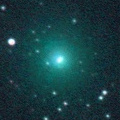
|
It brightened up to 11 mag in late 2018. Now it is 17.1 mag (Sept. 14, Ken-ichi Kadota). It will be fainter than 18 mag in November. It is observable in excellent condition in the Northern Hemisphere. It locates extremely low in the Southern Hemisphere.
Date(TT) R.A. (2000) Decl. Delta r Elong. m1 Best Time(A, h)
Oct. 5 3 45.30 48 40.4 3.366 3.975 121 17.3 2:54 (180, 76)
Oct. 12 3 38.48 48 7.2 3.348 4.039 127 17.4 2:20 (180, 77)
|
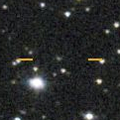
|
Now it is 17.6 mag (Sept. 7, Ken-ichi Kadota). It will stay at 14 mag for a long time from 2021 to 2022. In the Northern Hemisphere, it stays observable in good condition while brightening gradually, although it becomes low in December and January. In the Southern Hemisphere, it locates extremely low now, and it will be unobservable soon.
Date(TT) R.A. (2000) Decl. Delta r Elong. m1 Best Time(A, h)
Oct. 5 18 21.67 40 54.7 7.454 7.507 89 17.5 19:03 (114, 70)
Oct. 12 18 21.55 39 44.3 7.475 7.471 85 17.5 18:53 (110, 67)
|

|
Now it is 17.6 mag (Sept. 26, Toshihiko Ikemura, Hirohisa Sato). It will brighten up to 12 mag in winter in 2022.
Date(TT) R.A. (2000) Decl. Delta r Elong. m1 Best Time(A, h)
Oct. 5 22 9.20 46 41.2 7.075 7.712 126 17.6 21:14 (180, 78)
Oct. 12 22 6.54 46 15.2 7.050 7.667 125 17.6 20:44 (180, 79)
|

|
Now it is fading. In 2019, it is observable at 17.5 mag in good condition in autumn.
Date(TT) R.A. (2000) Decl. Delta r Elong. m1 Best Time(A, h)
Oct. 5 2 48.42 10 44.9 3.272 4.153 147 17.6 1:57 ( 0, 66)
Oct. 12 2 44.60 10 31.5 3.237 4.167 155 17.6 1:25 ( 0, 66)
|
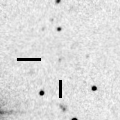
|
Now it is 18.5 mag (Sept. 22, Hidetaka Sato). It is observable at 17-18 mag for a long time from late 2019 to early 2021.
Date(TT) R.A. (2000) Decl. Delta r Elong. m1 Best Time(A, h)
Oct. 5 3 29.31 1 56.0 4.469 5.255 137 17.8 2:37 ( 0, 57)
Oct. 12 3 27.13 1 39.3 4.396 5.242 144 17.7 2:08 ( 0, 57)
|

|
First return of a new periodic comet discovered in 2006. It has not been recovered yet in this apparition. It will brighten up to 16.5 mag in 2020 spring. But it is not observable at that time. It will be observable at 18 mag in 2019 autumn and 2020 autumn.
Date(TT) R.A. (2000) Decl. Delta r Elong. m1 Best Time(A, h)
Oct. 5 18 56.40 -13 47.4 2.296 2.546 92 17.9 19:03 ( 19, 39)
Oct. 12 19 2.43 -14 33.2 2.339 2.497 87 17.8 18:53 ( 22, 38)
|

|
Now it is 18.6 mag (Sept. 25, Toshihiko Ikemura, Hirohisa Sato). It was exptected to brighten up to 16.5 mag from October to December. But actually, it is fainter than originally expected. It seems to brighten up to 18 mag at best. It is observable in good condition in the Northern Hemisphere. It locates low in the Southern Hemisphere.
Date(TT) R.A. (2000) Decl. Delta r Elong. m1 Best Time(A, h)
Oct. 5 7 26.28 14 47.5 1.452 1.619 80 18.4 4:33 (299, 56)
Oct. 12 7 43.68 16 15.5 1.388 1.611 83 18.3 4:39 (302, 60)
|

|
Now it is bright as 17.9 mag (Aug. 23, Hidetaka Sato). Hidetaka Sato reported it looks cometary with coma. It will be getting lower gradually after this.
Date(TT) R.A. (2000) Decl. Delta r Elong. m1 Best Time(A, h)
Oct. 5 18 3.16 -12 22.9 4.678 4.607 79 19.8 19:03 ( 35, 35)
Oct. 12 18 7.52 -12 38.7 4.778 4.604 74 19.8 18:53 ( 38, 34)
|
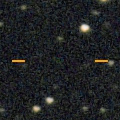
|
Now it is very faint as 19.8 mag (Sept. 25, Toshihiko Ikemura, Hirohisa Sato). It brightened up to 15.5 mag in 1997, and 17 mag in 2008, however, it is much fainter in this apparition.
Date(TT) R.A. (2000) Decl. Delta r Elong. m1 Best Time(A, h)
Oct. 5 1 26.45 19 4.3 2.354 3.318 161 20.1 0:35 ( 0, 74)
Oct. 12 1 22.67 18 25.3 2.340 3.323 168 20.1 0:04 ( 0, 74)
|

|
Now it is 19.5 mag (Oct. 2, Katsumi Yoshimoto). It will approaches to Earth down to 0.09 a.u. in early January. It will be obesrvable in excellent condition in the Northern Hemisphere. But it will be 17.5 mag at best. In the Southern Hemisphere, it will not be observable at the high light. It is a bit brighter than this ephemeris.
Date(TT) R.A. (2000) Decl. Delta r Elong. m1 Best Time(A, h)
Oct. 5 22 59.57 -23 52.0 0.493 1.423 142 20.9 22:04 ( 0, 31)
Oct. 12 22 48.15 -24 40.3 0.463 1.360 133 20.9 21:25 ( 0, 30)
|
|
![]()
 168P/Hergenrother
168P/Hergenrother 29P/Schwassmann-Wachmann 1
29P/Schwassmann-Wachmann 1 68P/Klemola
68P/Klemola C/2018 A6 ( Gibbs )
C/2018 A6 ( Gibbs ) 78P/Gehrels 2
78P/Gehrels 2 C/2019 A9 ( PanSTARRS )
C/2019 A9 ( PanSTARRS ) C/2016 M1 ( PanSTARRS )
C/2016 M1 ( PanSTARRS ) C/2017 B3 ( LINEAR )
C/2017 B3 ( LINEAR ) 101P/Chernykh
101P/Chernykh 2018 DO4
2018 DO4 C/2018 F4 ( PanSTARRS )
C/2018 F4 ( PanSTARRS ) C/2019 K1 ( ATLAS )
C/2019 K1 ( ATLAS ) 261P/Larson
261P/Larson C/2019 K5 ( Young )
C/2019 K5 ( Young ) A/2017 U7
A/2017 U7 C/2019 K7 ( Smith )
C/2019 K7 ( Smith ) 114P/Wiseman-Skiff
114P/Wiseman-Skiff C/2017 K2 ( PanSTARRS )
C/2017 K2 ( PanSTARRS ) 2I/2019 Q4 ( Borisov )
2I/2019 Q4 ( Borisov ) (3200) Phaethon
(3200) Phaethon 160P/LINEAR
160P/LINEAR 155P/Shoemaker 3
155P/Shoemaker 3 P/2019 R1 ( Boattini )
P/2019 R1 ( Boattini ) C/2018 A3 ( ATLAS )
C/2018 A3 ( ATLAS ) C/2019 K4 ( Ye )
C/2019 K4 ( Ye ) C/2015 O1 ( PanSTARRS )
C/2015 O1 ( PanSTARRS ) C/2016 N6 ( PanSTARRS )
C/2016 N6 ( PanSTARRS ) 384P/2019 O1 ( Kowalski )
384P/2019 O1 ( Kowalski ) C/2018 Y1 ( Iwamoto )
C/2018 Y1 ( Iwamoto ) C/2018 L2 ( ATLAS )
C/2018 L2 ( ATLAS ) C/2018 U1 ( Lemmon )
C/2018 U1 ( Lemmon ) C/2019 L3 ( ATLAS )
C/2019 L3 ( ATLAS ) 65P/Gunn
65P/Gunn 173P/Mueller 5
173P/Mueller 5 P/2006 W1 ( Gibbs )
P/2006 W1 ( Gibbs ) 76P/West-Kohoutek-Ikemura
76P/West-Kohoutek-Ikemura 2019 LD2
2019 LD2 200P/Larsen
200P/Larsen 289P/Blanpain
289P/Blanpain![]()





































